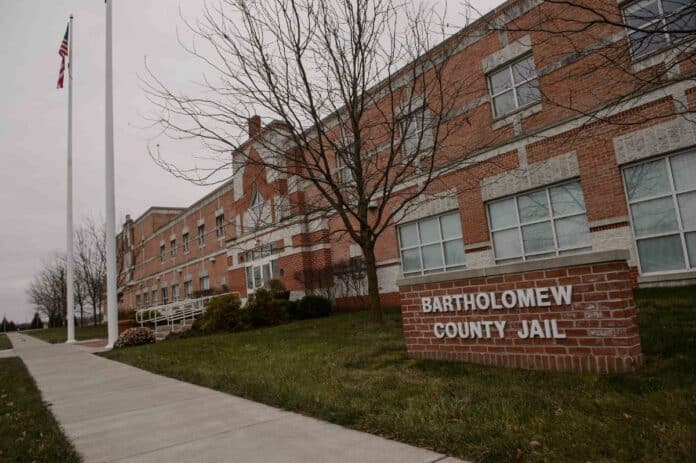The state’s Department of Correction has announced it will change the way counties are reimbursed for housing convicted low-level felons in local jails, with Bartholomew County receiving a reimbursement for expenses dating back to the last half of 2016.
Money owed to Bartholomew County for Department of Correction inmates housed at the Bartholomew County Jail for the last three years has not been paid until now, county officials said.
In a June 12 letter, DOC commissioner Rob Carter informed Bartholomew County officials they will be reimburse $286,895 for expenses incurred during fiscal year 2016-2017 — and $376,880 for those from fiscal year 2017-2018.
“Does the light company let you wait that long to pay your bill?” Bartholomew County commissioner Carl Lienhoop asked. “Not many of my creditors will let me go two-and-a-half to three years without paying.”
[sc:text-divider text-divider-title=”Story continues below gallery” ]
For the coming fiscal year that began July 1, Bartholomew County will receive $389,257 in a lump-sum payment that will be deposited this month in the county’s general fund, state officials said. This amount is based on the higher amount payed over the last two fiscal years, as well as the percentage of low-level felons housed at the jail in Columbus compared to the state total, Carter said.
“If you think we’re getting a nice warm fuzzy from this, we’re not,” said Bartholomew County Sheriff Matt Myers, who explained he does not find the current reimbursement rate sufficient.
At the beginning of that year, a state mandate went into effect that required any person convicted of a Level 6 felony sentenced to less than one year behind bars to serve their time in the county jail, rather than in a state penal facility. In exchange, the DOC would reimburse the county $35 per inmate per day.
While that rate has been $35 a day for the past three years, the Indiana Sheriff’s Association has been lobbying to get that amount raised to $55 a day, Myers said. Even the association’s recommendation falls short of the actual cost of between $80 to $85, Myers said.
“This is going to be more of a cost to the county,” Myers said.
With the lump-sum payment, Bartholomew County — which is now housing 40 to 45 low-level inmates for the state — is getting less funding, Myers said. He said if the average Level 6 inmate count were 40 each day, the reimbursement will only be about $26.66 per day per inmate.
“The higher number of low-level felons you hold, the less money you get,’ Myers said. “Over the years, our numbers usually go up — not down.”
And if that average rises up to 50 inmates per day, the sheriff says the rate will drops to $21.33 per inmate per day.
However, Carter states the DOC made these changes to support the following four outcomes:
By not requiring the convicted person to remain incarcerated in jail for a county to receive full funding, this method encourages greater collaboration between jail, Community Corrections, probation and other treatment and diversion programs.
No longer are counties required to develop detailed period billing, or gather court and jail records to track and validate billing.
Each county will receive an increase over past annual reimbursement amounts, and future amounts will be foreseeable with respect to amount and time received.
The new system eliminates the risk of future bills not being reimbursed should the appropriation reaches a zero balance.
County jails will still be reimbursed for those in jail awaiting transfer for a DOC facility, as well as medical care for inmates who have no other means to pay for the treatment, Carter said.
The jail will also continue to receive $45,435 annually for temporarily holding those convicted of misdemeanors, the DOC commissioner said. Those additional funds have been used recently to help pay for a nurse at the jail, Myers said.
In recent years, the state’s Department of Correction has suffered its own frustrations, the sheriff said. Much of it stems from all 92 Indiana counties seeking reimbursements at the same time, as well as being insufficiently staffed for detailed accounting of every low-level inmate statewide, Myers said. That’s likely why the state has shifted to making lump-sum payments, the sheriff said.
However, the announced funding doesn’t take into account extensive jail programming, recently-added services and required expansions locally, the sheriff said.
Bartholomew County commissioner Larry Kleinhenz agrees, adding that county jails were constitutionally established to house those who commit small local crimes.
“Kind of like the old Andy Griffith Show,” Kleinhenz said. “But now, our county jail is more like a penitentiary.”
If the current funding levels for housing Level 6 felons is accepted without question, Kleinhenz said he’s concerned the state may one day mandate that more serious criminals serve their sentences in jails, rather than state prisons.
County Commissioner Rick Flohr said the main issue is that the state is shifting some of their burdens down to counties.
“I think our elected officials at the statehouse saw a way to push their cost and their problems down to us,” Flohr said.
On the other hand, Bartholomew County is more fortunate than most counties because we have a unused section of jail capable of housing about 100 more inmates, space that is scheduled to open later this summer, Flohr said.
“There are a lot of other counties that will really struggle with this,” Myers said.
[sc:pullout-title pullout-title=”History of the mandate” ][sc:pullout-text-begin]
The Indiana bill that requires low-level felons to serve their sentences in county jails, rather than prisons, was passed by both the Indiana House and Senate in April, 2015.
House Bill 1006 was signed into law on May 5, 2015 by then-Indiana Gov. Mike Pence and went into effect as Public Law 179 on Jan. 1, 2016.
This bill states that felons convicted of Level 6 felonies no longer will be handled by the Indiana Department of Corrections. This placed the burden of dealing with low-level felons in the hands of each of Indiana’s 92 counties.
In addition, the bill removed funding for the construction and addition of prisons as requested in Pence’s budget, and allocated it for Community Corrections programs designed to address repeat criminal behavior.
The measure was introduced following a 2014 study backed by the Department of Justice that predicted Indiana’s prison population was expected to jump by at least 20 percent over the next three years.
[sc:pullout-text-end]





